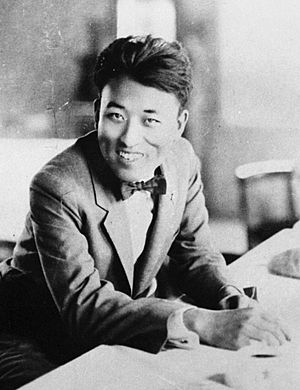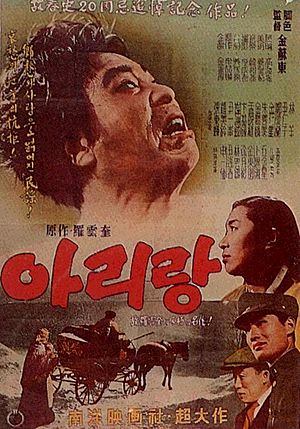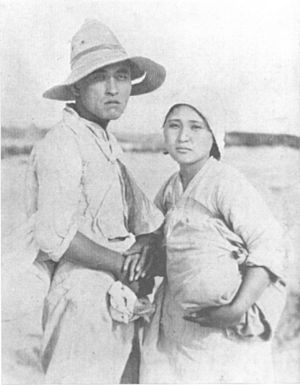Na Woon-gyu facts for kids
Quick facts for kids
Na Woon-gyu
|
|
|---|---|

Na Woon-gyu photography
|
|
| Born | November 26, 1902 |
| Died | August 9, 1937 (aged 34) |
| Occupation | Actor, screenwriter, director |
| Korean name | |
| Hangul | |
| Hanja | |
| Revised Romanization | Na Un-gyu |
| McCune–Reischauer | Na Ungyu |
| Art name | |
| Hangul | |
| Hanja | |
| Revised Romanization | Chunsa |
| McCune–Reischauer | Ch'unsa |
Na Woon-gyu (October 27, 1902 – August 9, 1937) was a very important Korean actor, writer, and director. Many people think he was the most important filmmaker in early Korean movies. He might even be Korea's first true movie star!
He often wrote, directed, and acted in his own films. This led some to say he started the idea of an "auteur" filmmaker in Korea. An auteur is a director whose movies show their unique personal style.
Contents
Early Life and Dreams
Na Woon-gyu was born in 1902. He was the third son of Na Hyong-gwon, who was a military officer. His father later became a teacher in their hometown of Hoeryong.
Becoming an Actor and Activist
When Na Woon-gyu was in high school, he loved theater and acting. He also took part in activities against the Japanese occupation of Korea. One big event was the March 1st Movement protest in 1919.
To avoid being held by the authorities, he spent two years traveling. He crossed the Tumen River many times, which is a river between Korea and Manchuria. He even went as far as Siberia. There, he joined Korean fighters who were working for Korea's freedom.
Discovering a Love for Movies
In 1921, Na Woon-gyu returned to Seoul. He started studying social science at Yonhui University (now Yonsei University). This is when he became truly fascinated with movies.
He would watch films in theaters and fill notebooks with his thoughts. He even carried a small hand mirror to practice different facial expressions.
A Pen Name and a New Start
Na Woon-gyu was later held by the Japanese because of his part in the March 1st Movement. While he was held in Chongjin from 1921 to 1923, he got his artistic pen-name, Chunsa. Another resistance fighter, Lee Chun-song, gave him this name.
After he was released in 1923, he joined a play group called Yerimhoe Play Troupe in his hometown. Later, he sold all his books to buy a train ticket to Busan. He wanted to act at the Choson Film Company. He started by playing small roles and then villains in their films. His first movie was UnYeongJeon in 1925.
A Star is Born: Na Woon-gyu's Film Career
Na Woon-gyu was described as short, but he could show a lot of anger and frustration on screen. This fit the feelings of the Korean people at that time. He first became well-known for playing the father in Simchong-jon (The Story of Shim Chong) in 1925.
Arirang: A National Sensation
His first film where he was the writer, director, and star was Arirang (1926). This movie became a huge hit across Korea!
Movies in Korea faced strict rules from the Japanese authorities. Scripts had to be approved before films could be made. Any criticism of the government was not allowed. This meant most films were melodramatic, a style called shinpa.
Na Woon-gyu's special idea in Arirang was to combine the shinpa style with a feeling of Korean nationalism. He found a way to show Korean opposition to the Japanese rule without directly saying it. This made cinema in Korea more than just entertainment. It became a way to express national resistance.
Na Woon-kyu Productions
In September 1927, Na Woon-gyu started his own film company called Na Woon-kyu Productions. It was funded by Park Sung-pil, who owned the Dansongsa Theater.
His company aimed to make films by Koreans, for Koreans. This was different from the Japanese-run studios.
Challenges and Later Films
Na's 1929 film Salangeul chajaseo was a big movie with over a thousand extra actors. Like Arirang, this film was inspired by Na's own life. It was about Koreans crossing the Tumen River to find freedom from Japanese rule.
The film was first banned, but it was later released after being heavily changed. However, his next film, Beongeoli Sam-ryong (1929), did not do well. This led to the closing of Na's studio.
Arirang started a time of nationalist films in Korea, from 1926 to about 1930. After this, the authorities became even stricter. Some of Na's later films were criticized for being just tear-jerker shinpa movies, without a deeper national message.
Korean director Yu Hyun-mok said that Na's appearance with a Japanese woman in the 1931 film Geumganghan was seen as a betrayal by some Koreans. This had a very negative effect on his career.
Na Woon-gyu had poor health throughout his life. He passed away at the age of 34 in 1937. Even though his career was short, he made many films during the "Golden Age of Silent Films" in Korea. In about ten years, he acted in twenty-six movies and directed fifteen!
Na Woon-gyu's Lasting Legacy
Na Woon-gyu is still seen as one of the most important people who started Korean cinema. His funeral procession was led by a band playing Arirang. Many people came to mourn him, even in the rain.
In November 1938, a newspaper poll for the best silent Korean films put Arirang at number one. Two other films by Na Woon-gyu were also in the top ten: Sarangul Chajaso (Looking for Love) and Punguna (The Man with Great Ambition). His last film, Omongnyo (1937), was second on the list of best sound films made in Korea.
Tributes and Memorials
Na Woon-gyu's life was made into a movie in 1966 called Na Woon-Gyui ilsaeng. It was directed by and starred Choi Mu-ryong.
The Korea Film Directors' Society honored Na Woon-gyu by naming their Chunsa Art Film Festival after his pen name. This festival started in 1990.
In Seoul, a place near "Arirang Hill" was turned into a "Street of Motion Pictures." It has the Arirang Cine Center, a library, a small theme park, and a monument. The monument celebrates the 100th anniversary of Na Woon-gyu's birth. An annual film festival is also held there.
Na Woon-gyu was a big influence on other filmmakers, like Shin Sang-ok.
Filmography
- UnYeongJeon (운영전) (1925)
- Simchong-jon (심청전) (The Story of Shim Chong) (1925)
- JangHanMong (장한몽) (1926)
- Nongjungjo (농중조) (1926)
- Arirang (아리랑) (1926)
- Punguna (풍운아) (Soldier of Fortune) (1926)
- Deuljwi (들쥐) (The Wild Rat) (1927)
- Heukkwa Baek (흑과백) (Black and White) (1927)
- Geumbungeo (금붕어) (Goldfish) (1927)
- Jalitgeola (잘 있거라) (Farewell) (1927)
- Ok-nyeo (1928) (옥녀)
- Beongeoli Sam-ryong (벙어리 삼룡) (Deaf Sam-ryong) (1929)
- Salangeul chajaseo (사랑을 찾아서) (In Search of Love) (1929)
- Sanai (사나이) (1929)
- Arirang geuhu iyagi (아리랑 그 후 이야기) or Arirang hu pyeon (아리랑 후편) (Arirang 2) (1930)
- Cheolindo (철인도) (1930)
- Geumganghan (금강한) (The Grief of Geumgan) (1931)
- Nampyeuneun Kyeongbidaero (남편은 경비대로) (1931)
- Gaehwadang imun (개화당 이문) (1932)
- Imjaeobtneun naleutbae (임자없는 나룻배) (The Ownerless Ferryboat) (1932)
- Amgunwang (암굴왕) (1932)
- Jongno (종로) (1933)
- Muhwagwa (무화과) (Fig Tree) (1935)
- Kanggeonneo maeul (강 건너 마을) (Town Across the River) (1935)
- Geulimja (그림자) (Shadow) (1935)
- Hwangmuji (황무지) (1935)
- Arirang 3 (아리랑 제3편) (1936)
- Chilbeontong sosageon (칠번통 소사건) (Incident of the 7th Bamboo Flute) (1936)
- Oh Mong-nyeo (오몽녀) (1937)



